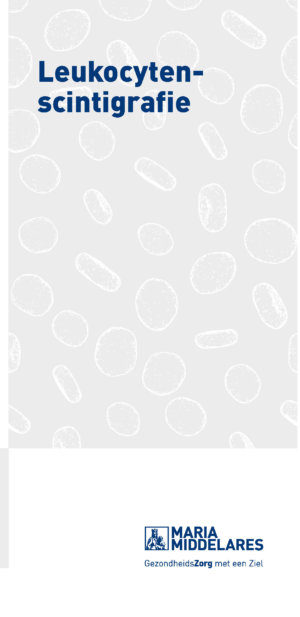White blood cell scan
What is it?
What is it?Leukocytes, or white blood cells, play an important role in every inflammation. Through this test, we can detect areas of infection in your body and distinguish between infection and sterile inflammation. An important indication for this is the follow-up of infected orthopaedic prostheses. In this case, a skeletal scintigraphy will be requested in addition to a white blood cell scintigraphy so that the images can be compared.
Course of the procedure
Course of the procedurePregnancy and breastfeeding
Are you pregnant or do you think you may be pregnant? Or are you breastfeeding? Please tell the physician before the injection. The test will not be performed if you are pregnant. If you are not sure whether you are pregnant or not, the test will be postponed until you are certain.
If you are breastfeeding, make sure to discuss this with the physician before the test. You will receive additional instructions about how to avoid unnecessary radiation exposure to your child.
Preparation for the test
Fasting is not required for this test. You are allowed to eat as per normal between the injection and the scan. It is recommended that you drink a few extra glasses of water.
Please take into account that you will need to wait for about two to four hours after the blood draw and one hour after the injection, and that you need to come back in the afternoon (four hours after the injection). You do not need to remain in the hospital during the hours in between.
Procedure
The procedure consists of different parts:
Labelling of the own white blood cells in vitro
First, blood samples are taken to collect a sufficient number of white blood cells. In the laboratory at the Nuclear Medicine Department, the white blood cells are removed and labelled with a small quantity of radioactive material. This takes approximately two to four hours. You do not need to remain in the department during this time.
Injection of the own, radioactively labelled, white blood cells
The labelled white blood cells are intravenously injected back in.
In specific cases, an alternative method must be used. This will be done by means of an injection of labelled antibodies that bind to the wall of white blood cells.
Recording images
Recordings are made three times: one hour, four hours and 24 hours after the injection.
The recording after one hour only takes five minutes. The recording after four hours takes 45 minutes. We start with an overview of the entire body. Additionally, 3D recordings (‘SPECT’) are made which involves the camera revolving around you to scan all body parts that need examining in all directions. This is often combined with a CT scan. The recording after 24 hours takes 30 minutes.
After the test
You may leave the department after every scan.
Safety and radiation
Safety and radiationThere are essentially no side effects: the injected product causes no abnormal sensations and only in very rare cases causes (very mild) allergic reactions. The injected radioactive material does constitute a dose of radiation, but it is very small (about as much as for a regular CT scan).
The quantity of radiation that you are exposed to during the test is not higher or lower depending on the number of images taken.
The radioactive substance will have disappeared almost completely from your body after 12 hours.
It is recommended that children younger than the age of 6 do not sit on your lap for more than half an hour during the first six hours after the test. Playing, feeding, changing sheets and nappies and other daily activities are no problem.
Prolonged contact (longer than one hour) in close proximity (less than one metre) with pregnant women during the first 12 hours should be avoided too.
Results
ResultsWe prepare a report of the test. That report and the images are digitally available to the physician who requested the test.
Leaflet
LeafletYou can read all of this information in the leaflet below:
Only available in Dutch:

Leukocytenscintigrafie
DownloadCentres and specialist areas
Centres and specialist areas
Latest publication date: 28/12/2023
Supervising author: Dr Van Den Bossche Bieke



